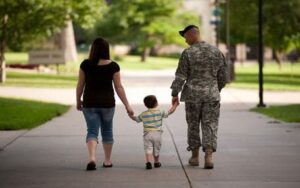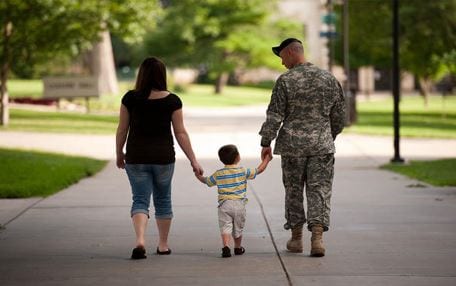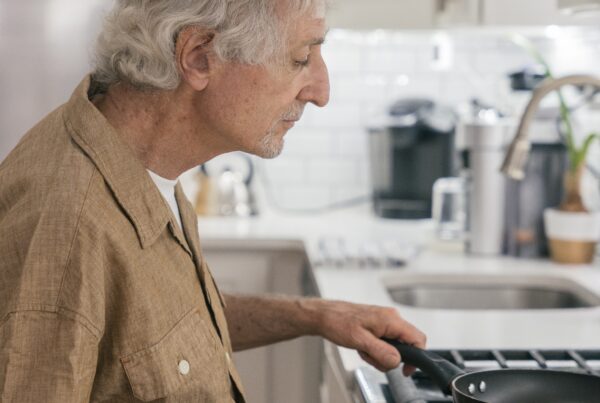by: Jennifer Rea, Ph.D.
The coronavirus pandemic brings with it a great deal of ambiguity, fear, and shifts in the way Americans are living their lives. Many have referred to this time as unprecedented, as it is a period of lots of change, or a stint of developing a new normal.

Used with permission by Military.com
For military families, change is not new. Most military families are resilient and have become equipped with various strengths.
These skills enable them to adapt and become flexible through various transitions, such as deployments.
As professionals, we can learn from military families. By building upon their existing strengths we can hopefully minimize the stress and uncertainty that COVID-19 has brought on.
Our OneOp Family Transitions team concentrates on providing professional development and engagement opportunities for military family service professionals who work with military families to build resilience and navigate life cycle transitions.
We want you to know that we are here for you.
We have compiled a list of resources to help you acclimate new ways of serving military families during this time of uncertainty and change.
In this post we highlight changes or shifts that military families may be currently experiencing and provide a list of resources to help navigate them.
We encourage you to try new things but give yourself, your colleagues, and the families you serve grace! Your willingness and flexibility to think outside the box may be the key to helping military families thrive during this time!
*For the most up-to-date information and resources regarding COVID-19, refer to the guidance of the U.S. Centers for Disease Control and Prevention (CDC) , the World Health Organization (WHO) and the Military Health System.
#1 The Shift: Social Distancing
What is social distancing and why is it recommended?
According to Lisa Maragakis, M.D., M.P.H., “social distancing is deliberately increasing the physical space between people to avoid spreading illness. Staying at least six feet away from other people lessens your chance of catching COVID-19”.
Examples of social distancing to avoid larger crowds or populated spaces include working from home instead of at the office, closing schools or switching to online classes, and visiting with loved ones via technology.
While different in terms of wording and purpose, self-quarantine and isolation also serve in a similar way to social distancing by slowing the rate of infection.
Resources
• Stay connected. Check on military families by calling, texting or using an app like GroupMe. Advise them to reach out to those they love. Host a virtual gathering on Facebook Live or Zoom. It doesn’t matter how we connect, but that we connect.
• The Center for the Study of Traumatic Stress provides fact sheets addressing the needs of healthcare personnel, businesses, families, and communities.
• Military OneSource has a section to provide you with resources, updates and information about the impacts of COVID-19 on the military community.
Many families may experience increased anxiety and stress as a result of COVID-19. Help Service members and their families shift their perspectives from being “stuck” in their homes to getting “unexpected bonus time”.
Resources geared toward health and well-being include:
• Taking Care of Yourself in Isolation provides strategies to manage stress through self care (UMN Extension)
• COVID-19 research guide includes how to cope with anxiety and its impacts on mental health (Renner Academic Library and Learning Resources)
• Are You Prepared to Provide Mental Health First Aid? blog post by OneOp Family Transitions
• Supporting Military Families During the Coronavirus Outbreak blog post by OneOp Community Capacity Building
• Disaster Mental Health Information: Pandemics American Psychological Association provides resources for practitioners, caregivers and more.
• Dr. Heidi Radunovich, University of Florida licensed clinical psychologist shares ideas on managing stress during a pandemic for adults and children.
• Helping Children Cope (UMN Extension)
• Love in the time of Corona: How to stay connected with family when we “gotta keep ’em separated” (Council on Contemporary Families)
• Protecting Your Marriage from Becoming Another Coronavirus Victim (Institute for Family Studies)
• Resources for Supporting Children’s Emotional Well-being during the COVID-19 Pandemic (Child Trends)
• Stress, Resilience, and the Role of Science: Responding to the Coronavirus Pandemic (Center on the Developing Child at Harvard University)
#2 The Shift: Working from Home
Due to social distancing, many have shifted to working from home instead of at the office. This is also likely true for the military families you serve. This change may also involve taking care of children (e.g., due to schools or daycares closing), while also attempting to get work done from home.
Resources
• Alabama Cooperative Extension (ACES) Coronavirus: Physical Activity & Kids
• America’s Promise Alliance COVID-19 Resource List resources for educators, school staff and families.
• National Council on Family Relations offers COVID-19 resources to help those working from home with kids.
Here are a few examples geared toward managing your work from home:
8 Tips to Make Working From Home Work For You (National Public Radio)
How to Work from Home Without Losing Your Sanity (CNN)
#3 The Shift: Accessibility to Household Essentials
As a result of social distancing, isolation or self-quarantine, families may have limited access to household items. It’s important to remember that anyone can get sick, regardless of where they live or where they come from. You can assist military families by ensuring they have enough household essentials on-hand to thrive for at least two weeks.
Resources
• A Guide: How To Prepare Your Home For Coronavirus (National Public Radio-NPR)
• Coronavirus disease (COVID-19) Advice for the Public (World Health Organization)
• COVID-19 Food Safety Resources (North Carolina State University Extension)
• Helping your family plan for COVID-19 (UMN Extension)
o 14-day Menu Kit that can be used to help families plan ahead
• How to prepare your home, your workplace, and yourself for a pandemic (Fast Company)
• How to stockpile healthy and nutritious food for a 14-day quarantine as coronavirus spreads across the US (Business Insider)
• Other options might be to check out online grocery pick up services available in your community
• Preparing for a Coronavirus Quarantine (Penn State Extension)
• There are several resources for 3-day or 2-week supplies of emergency food and a guide that address the importance of food and water as well.
• Reach out to schools in your area to get more information on whether school districts are providing meals for families in need.
In the comment section, share additional shifts you are encountering and resources you have found to be helpful as you work with military families.
This article was written by Jennifer Rea, PhD and military spouse to an Active Duty Marine. Jenny consults with the OneOp Family Transitions team to support professional development for military family service providers. You may find more blogs, podcasts and webinars from Family Transitions. We invite you to engage with Family Transitions on Twitter @MFLNFT and with OneOp on Facebook @MilitaryFamilies.
References
1. Maragakis, L. L. (2020). Coronavirus, Social Distancing and Self-Quarantine. Retrieved from https://www.hopkinsmedicine.org/health/conditions-and-diseases/coronavirus/coronavirus-social-distancing-and-self-quarantine















